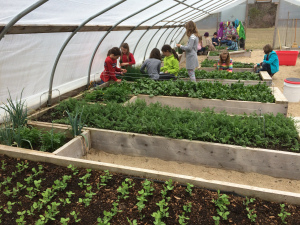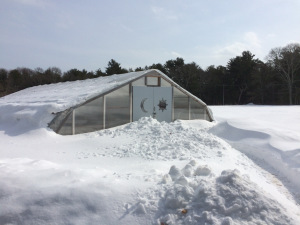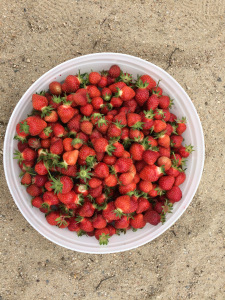For the body and the mind – THIS is growth!
 A few years ago the children at our school grew, harvested and, ultimately, ate a giant, two-pound carrot.
A few years ago the children at our school grew, harvested and, ultimately, ate a giant, two-pound carrot.
Our organic gardening program at the Waldorf School of Cape Cod has come a long way since then. We now have a unheated Sunhouse and a program where middle school gardeners lead first through fifth graders as they learn to build soil, plant, transplant, tend, water and harvest food year round. Our harvests are transformed by our school chef into amazing meals served at lunch.
~ Teachers and Educators ~
NOTE: You can now follow our progress on Twitter at the School Sunhouse Diary here.
NOTE: To receive updates about our conferences and publications about year round gardening in schools, follow this blog and/or like Growing Children on Facebook here. We strongly recommend following the blog AND liking Growing Children on Facebook as some of our Facebook posts seem to not reach everyone who liked the page.
The summer tending of the garden is a community responsibility. We have weekly Family Gardening sessions organized by grade level where families share a pot luck meal and then work together in the garden in the cool of the evening.

Winter gardening classes are in the Sunhouse where we harvest spinach, kale, carrots and more
The 24 by 48 feet Sunhouse is the heart of our gardening program. It is an indoor gardening classroom that aligns the school year with garden life by spreading the harvest over four seasons. Since it is unheated, we choose winter crops such as carrots, spinach and kale that grow when the nights are very cold and the days are slightly warm. A sunny day in February can bring temperatures in the 20s outside and in the sixties in the Sunhouse. The night lows in the hoop house can go into the teens or 20s, Yet, since the soil is warmed by the sun during the day, the soil in the beds never freezes. Our inspiration for the growing methods we use comes from Eliot Coleman who has written books about growing in four seasons in Maine.
Our spring Sunhouse harvests are substantial. We have early strawberries, bushels of spinach and baby kale, lots of chives and parsley and snow peas. The plastic roof is removed for the summer months to avoid overheating.
 Most greenhouse farmers cover most of their indoor space with plants. We are growing kids as well as plants, so only half the space in the greenhouse is covered with growing beds. We have a space to congregate at one end. The children had the idea to use sand rather than gravel between the beds and this has made the hoop house serve double duty as a protected winter sandbox. The used structure was bought through Craigslist and dedicated parents rebuilt the structure at school and built garden beds.
Most greenhouse farmers cover most of their indoor space with plants. We are growing kids as well as plants, so only half the space in the greenhouse is covered with growing beds. We have a space to congregate at one end. The children had the idea to use sand rather than gravel between the beds and this has made the hoop house serve double duty as a protected winter sandbox. The used structure was bought through Craigslist and dedicated parents rebuilt the structure at school and built garden beds.
While every student in the school devotes some time each year to growing lunch, each year the third graders are our weekly farmers. They are in charge of turning lunch scraps into compost in our tumbling composter. And, a worm bed in the hoop house creates vermicompost with the help of thousands of red worms.
I am continually awed by the energy and engagment children pour into all aspects of gardening. Our local newspaper made a video about the giant carrot that shows their tremendous enthusiasm.
This week my class is studying botany and specifically the growth of seeds by tucking seeds between the wall of a clear plastic tub and a few layers of wet paper towels. I gave the class permanent markers so they could write their own names on the tubs. Soon I realized that the quart containers were covered with more than their own names. They had given each seed a name: Poseidon, Zeus, Heidi! Now, each morning, I hear delighted exclamations, “One of our beans has sprouted! Heidi has a root!” “We have a sprouted leek seed. You have to look quite carefully to see it.” This is a hands-on exploration of monocotyledons (the leek is an example) and dicotyledons (the bean is an example). The children are learning those terms and what they mean. But, in my mind, even more vital is that they are given the opportunity to celebrate life. This part of the lesson does not need to be taught. It just rises up from within them, as naturally as the rising of the sun, as irrepressibly as the sprouting of the bean seed.
We seem to be a culture that is anxious about whether our children are learning enough, learning soon enough, learning exactly the right information. But, in the end, it is enthusiasm and care for life and learning that will carry them. Who can list with any certainly all of the facts, understandings and skills our children will need to possess twenty, thirty and forty years from now? Certainly, they will need to assimilate much that we cannot even imagine. (If you are my age you know that forty years ago you could never have imagined taking pictures with your phone, nor could anyone have pictured then the tech jobs of this decade.)
Why teach gardening? To help children make good food choices? Yes. To learn about botany? Yes. To bring healthy exercise into the school day? Yes. To give children an understanding of the work behind their food? To teach them how to grow their own food ? Yes. But, most of all, let’s grow with children in order to fuel their natural enthusiasm for life.
Written by Kim Allsup for and published by Growing Children
Written by Kim Allsup for and published by Growing Children ~ September 19, 2017.
 ~ The Author ~
~ The Author ~
Kim Allsup’s childhood wonder years inspired her first career as an environmentalist and her second career as a Waldorf teacher. She was the founding staff member of the Buzzard Bay Coalition and a founding parent of the Waldorf School of Cape Cod. A graduate of Brown University and Antioch University (M.Ed), she served as a Waldorf class teacher, on Cape Cod and at the Pine Hill Waldorf School, for 22 years. She is currently a writer, an advisor to teachers and a gardening teacher pioneering the use of school sunhouses. She lives on Cape Cod with her husband and blogs at Growing Children.
She is the author of A Gift of Wonder, A True Story Showing School as it Should Be.
